Paper Menu >>
Journal Menu >>
 Wireless Sensor Network, 2009, 1, 284-292 doi:10.4236/wsn.2009.14035 Published Online November 2009 (http://www.scirp.org/journal/wsn). Copyright © 2009 SciRes. WSN The Estimation of Radial Exponential Random Vectors in Additive White Gaussian Noise P. Kittisuwan1, S. Marukatat2, W. Asdornwised1 1Department of Electrical Engineering, Faculty of Engineering, Chulalongkorn University, Bangkok, Thailand 2Image Laboratory, National Electronics and Computer Technology Center (NECTEC), Thailand Email: pichidkit@yahoo.com, sanparith.marukatat@nectec.or.th, widhyakorn.a@chula.ac.th Received April 22, 2009; revised June 15, 2009; accepted J un e 22, 2009 Abstract Image signals are always disturbed by noise during their transmission, such as in mobile or network commu- nication. The received image quality is significantly influenced by noise. Thus, image signal denoising is an indispensable step during image processing. As we all know, most commonly used methods of image de- noising is Bayesian wavelet transform estimators. The Performance of various estimators, such as maximum a posteriori (MAP), or minimum mean square error (MMSE) is strongly dependent on correctness of the proposed model for original data distribution. Therefore, the selection of a proper model for distribution of wavelet coefficients is important in wavelet-based image denoising. This paper presents a new image de- noising algorithm based on the modeling of wavelet coefficients in each subband with multivariate Radial Exponential probability density function (PDF) with local variances. Generally these multivariate extensions do not result in a closed form expression, and the solution requires numerical solutions. However, we drive a closed form MMSE shrinkage functions for a Radial Exponential random vectors in additive white Gaussian noise (AWGN). The estimator is motivated and tested on the problem of wavelet-based image denoising. In the last, proposed, the same idea is applied to the dual-tree complex wavelet transform (DT-CWT), This Transform is an over-complete wavelet transform. Keywords: MMSE Estimator, Radial Exponential Random Vectors, Wavelet Transform, Image Denoising 1. Introduction The denoising of a natural image corrupted by Gaussian noise is a classic problem in signal processing. The distor- tion of images by noise is common during its, acquisition, processing, compression, mobile and network transmis- sion. Traditional algorithms perform image denoising based on threshold function methods, such as soft-thresh- old and hard-threshold [1]. If the wavelet transform and MMSE estimator are used for this problem, the solution requires a priori knowledge about wavelet coefficients. Therefore, two problems arise: 1) what kinds of distribu- tions represent the wavelet coefficients? 2) What is the corresponding estimator (shrinkage function)? Figure 1 illustrates the histogram of photographic image and PDF plots. The PDF plots illustrate the mar- ginal Radial Exponential PDF and Gaussian PDF. The histogram in Figure 1 is very symmetric with zero mean and the histogram of wavelet coefficients are more like marginal Radial Exponential PDF, it is more peaked and the tails are heavier, than the Gaussian distribution. It is known that the amplitude of wavelet coefficients tend to propagate across scales. This parent-child relation is also underlined by the empirical joint histogram be- tween parent and child coefficients as shown in [2]. In [3], they developed a multivariate spherically contoured Laplacian density that is similar to the Radial Exponential random vectors in its function form, but the marginal of Laplacian random vectors are not Radial Exponential den- sity. Indeed, Radial Exponential random vectors specialize to Laplacian random vectors in the scalar case 1d . In this paper we focus on Radial Exponential random vectors with local variances to model these locality and persis- tence properties of wavelet coefficients. The rest of this paper is organized as follows. In Section 2, the basic idea of Bayesian denoising will be briefly described. Subsec- tion 2.1 describes wavelet coefficients model, these mod- ls try to capture the dependencies between a coeffi- e 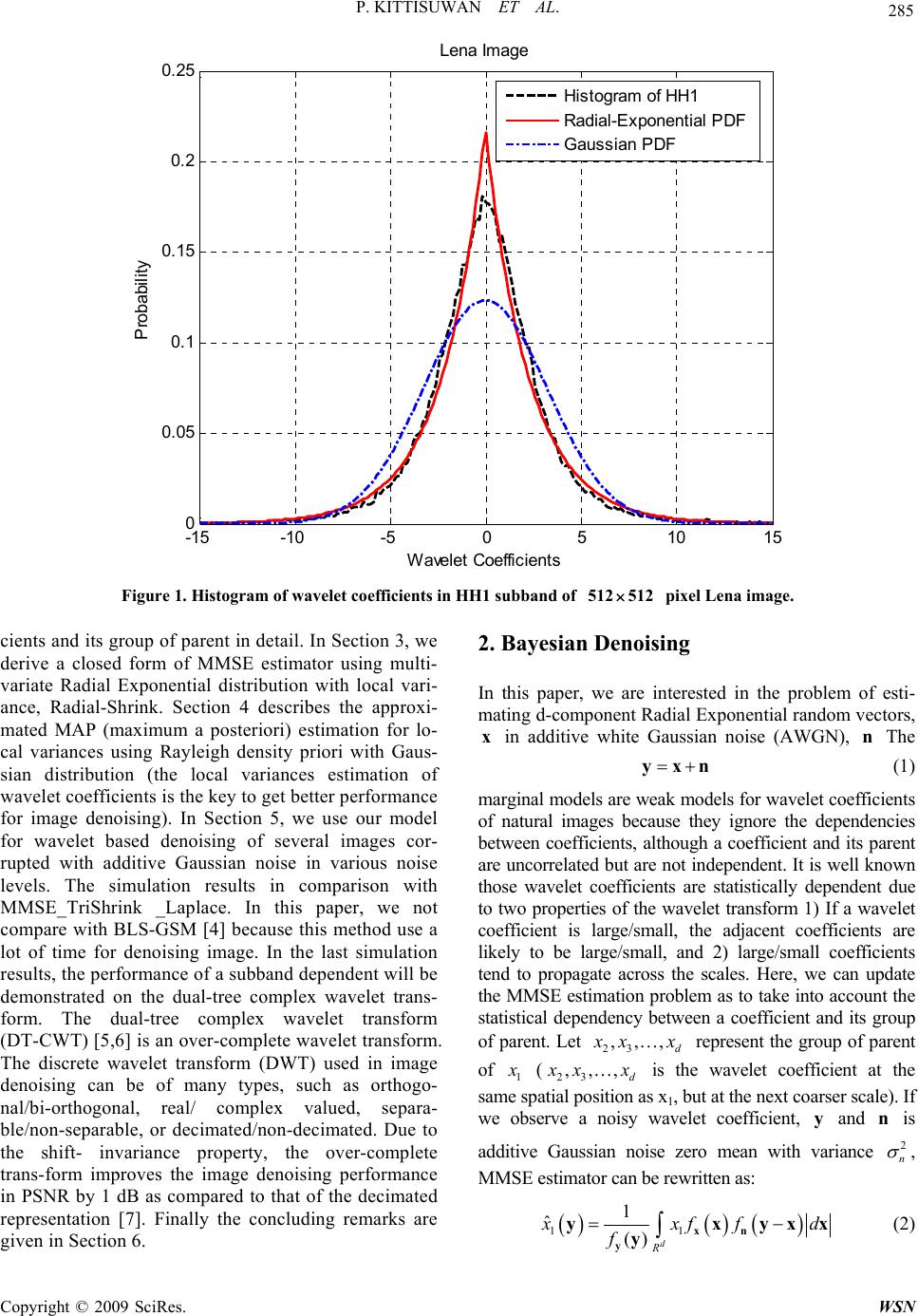 P. KITTISUWAN ET AL. Copyright © 2009 SciRes. WSN 285 -15 -10-5 05 10 15 0 0.05 0.1 0.15 0.2 0.25 Wa vel e t Co e ffic ien ts Probability Lena Image Histogram of HH1 Radial -Exponential PDF Gaussi an P DF Figure 1. Histogram of wavelet c oefficients in HH1 subband of 512512 pixel Lena image. cients and its group of parent in detail. In Section 3, we derive a closed form of MMSE estimator using multi- variate Radial Exponential distribution with local vari- ance, Radial-Shrink. Section 4 describes the approxi- mated MAP (maximum a posteriori) estimation for lo- cal variances using Rayleigh density priori with Gaus- sian distribution (the local variances estimation of wavelet coefficients is the key to get better performance for image denoising). In Section 5, we use our model for wavelet based denoising of several images cor- rupted with additive Gaussian noise in various noise levels. The simulation results in comparison with MMSE_TriShrink _Laplace. In this paper, we not compare with BLS-GSM [4] because this method use a lot of time for denoising image. In the last simulation results, the performance of a subband dependent will be demonstrated on the dual-tree complex wavelet trans- form. The dual-tree complex wavelet transform (DT-CWT) [5,6] is an over-complete wavelet transform. The discrete wavelet transform (DWT) used in image denoising can be of many types, such as orthogo- nal/bi-orthogonal, real/ complex valued, separa- ble/non-separable, or decimated/non-decimated. Due to the shift- invariance property, the over-complete trans-form improves the image denoising performance in PSNR by 1 dB as compared to that of the decimated representation [7]. Finally the concluding remarks are given in Section 6. 2. Bayesian Denoising In this paper, we are interested in the problem of esti- mating d-component Radial Exponential random vectors, in additive white Gaussian noise (AWGN), The x n y xn (1) marginal models are weak models for wavelet coefficients of natural images because they ignore the dependencies between coefficients, although a coefficient and its parent are uncorrelated but are not independent. It is well known those wavelet coefficients are statistically dependent due to two properties of the wavelet transform 1) If a wavelet coefficient is large/small, the adjacent coefficients are likely to be large/small, and 2) large/small coefficients tend to propagate across the scales. Here, we can update the MMSE estimation problem as to take into account the statistical dependency between a coefficient and its group of parent. Let 23 ,,, d x xx represent the group of parent of 1 x (23 ,,, d x xx is the wavelet coefficient at the same spatial position as x1, but at the next coarser scale). If we observe a noisy wavelet coefficient, and is additive Gaussian noise zero mean with variance , MMSE estimator can be rewritten as: y n 2 n 11 1 ˆ()d R x xf fd f xn y y x y xx y (2) 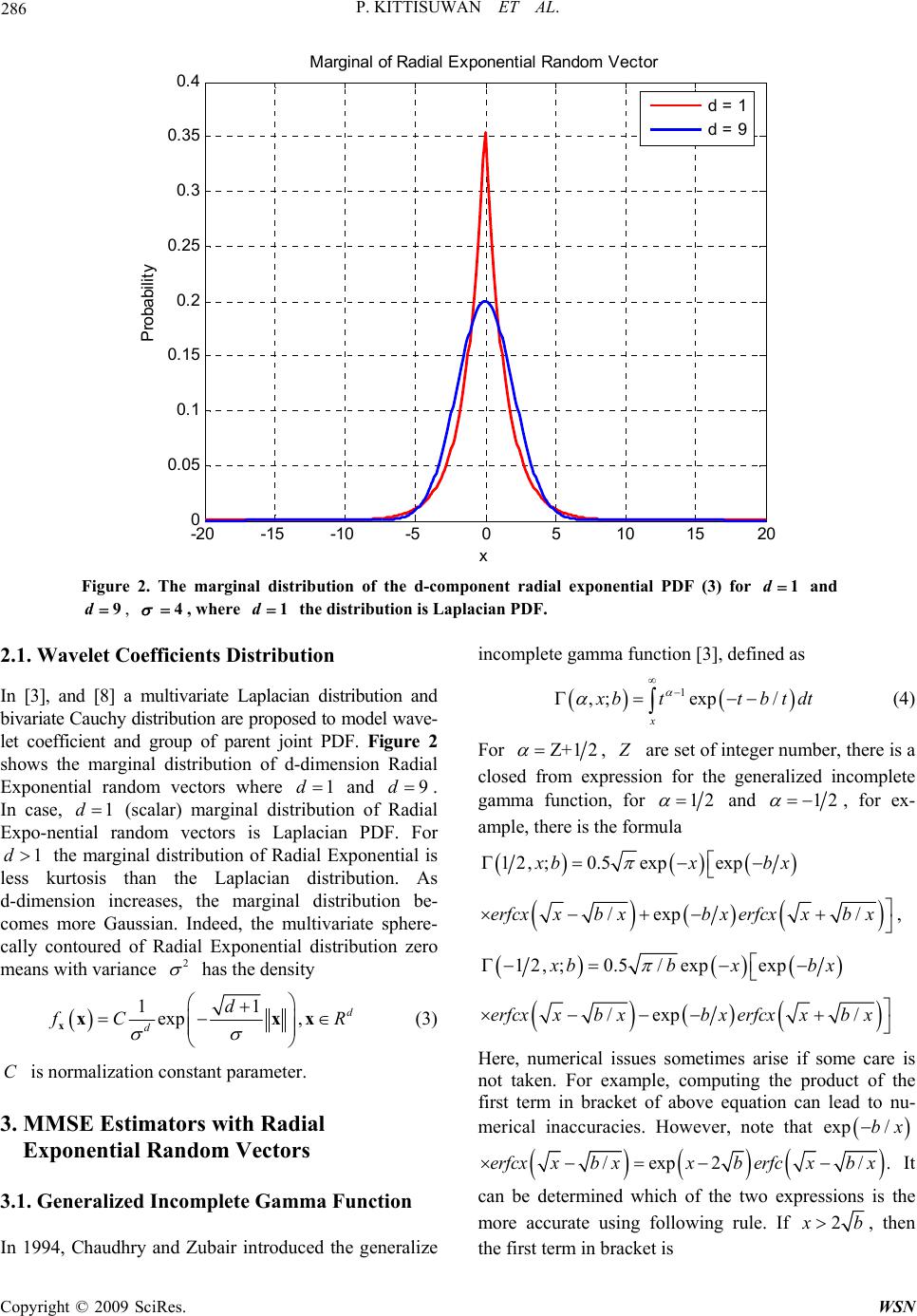 P. KITTISUWAN ET AL. Copyright © 2009 SciRes. WSN 286 -20 -15 -10 -5 0510 1520 0 0.05 0.1 0.15 0.2 0.25 0.3 0.35 0.4 x Probability Margi nal of Radial E xponent i al Random V ector d = 1 d = 9 Figure 2. The marginal distribution of the d-component radial exponential PDF (3) for and , 1d 9d24 , where the distribution is Laplacian PDF. 1d 2.1. Wavelet Coefficients Distribution In [3], and [8] a multivariate Laplacian distribution and bivariate Cauchy distribution are proposed to model wave- let coefficient and group of parent joint PDF. Figure 2 shows the marginal distribution of d-dimension Radial Exponential random vectors where and 1d9d . In case, (scalar) marginal distribution of Radial Expo-nential random vectors is Laplacian PDF. For the marginal distribution of Radial Exponential is less kurtosis than the Laplacian distribution. As d-dimension increases, the marginal distribution be- comes more Gaussian. Indeed, the multivariate sphere- cally contoured of Radial Exponential distribution zero means with variance 1d 1d 2 has the density 11 exp, d d d f CR xxx x (3) C is normalization constant parameter. 3. MMSE Estimators with Radial Exponential Random Vectors 3.1. Generalized Incomplete Gamma Function In 1994, Chaudhry and Zubair introduced the generalize incomplete gamma function [3], defined as 1 ,;exp / x x bt tbtd t (4) For Ζ+12 , Z are set of integer number, there is a closed from expression for the generalized incomplete gamma function, for 12 and 12 la , for ex- ample, there is the formu 12, ;0.5expexp x bx bx /exp /erfcxxb xbxerfcxxb x , 12, ;0.5/expexp x bbx bx /exp /erfcxxb xbxerfcxxb x Here, numerical issues sometimes arise if some care is not taken. For example, computing the product of the first term in bracket of above equation can lead to nu- merical inaccuracies. However, note that exp /bx /exp2 /erfcx xbxxberfc xbx . If It can be determined which of the two expressions is the more accurate using following rule. 2 x b, then the first term in bracket is  P. KITTISUWAN ET AL. 287 exp// .bxerfcxxbx Other cases, the first term in the bracket is exp 2 x b /erfcxb x. Indeed, the generalized incomplete gamma function sat- isfies a recurrence relation for computing its values for other order, from [9,10] 1 ( 1,;)1,;,; x bxb b xb exp/ . x xbx (5) 3.2. MMSE Estimator with Multivariate Radial Exponential D is t r i b u t i on Multivariate spherically contoured of Radial Exponential density can be generated by x zxs, where is d-component zero mean iid Gaussian ran- dom vectors with variance s 2 2 22 2 1exp 2 2d f s s s and is a gamma PDF . The two distribution are iid. Setting z() 4exp(2) z fz zz,0z az , then . Changing the random variable of asx ,,zasx. Using Jacobian transform 21d J aa, then the PDF of random vectors is given by x 2 0 z f Jf afda a xs x x 2 0 1 2z d afaf a a sxda (6) From MMSE estimator (2), we would like to find ()fy y and d R A ff d xn xyxx. If the noise sig- nal is independent additive white Gaussian noise (AWGN) with variance n 2 n , 2 22 2 1exp 2 2dn n f n n n First, the PDF of is given by the multivariate convolution. The multivariate convolution defines as: y ()() () d R f ff d yxn yxyxx (7) Using (6) gives 2 0 1 2 dz d R fafafdaf a a ys x yyd n xx 2 0 1 2 d zd R af affdda a a sn xyx x Using Gaussian convolution formula [3] 1 dd R ff d a a sn xyxx 2 22 22 2 22 2 11 exp 2 2dd n na a y Therefore, 2 22 22 2 0 11 2 2 zdd n fafa a yy 2 22 2 exp 2n da a y 3 2 222 2 0 2 2 22 2 8 2 exp 22 d d n n a a ad a ya Changing the variable of integration, using 222 22, 4 n t adt ada , gives 22 2 2 exp 2n d f yy 2 2 2 22 22 2 2exp n n d ttd tt yt Using the generalized incomplete gamma function in (4), we get 2 22 2 222 2 exp 22 ()2 ,; 2 () nn d d f y y y 2 22 22 22 1, ; 2 nn d y 2 (8) Copyright © 2009 SciRes. WSN 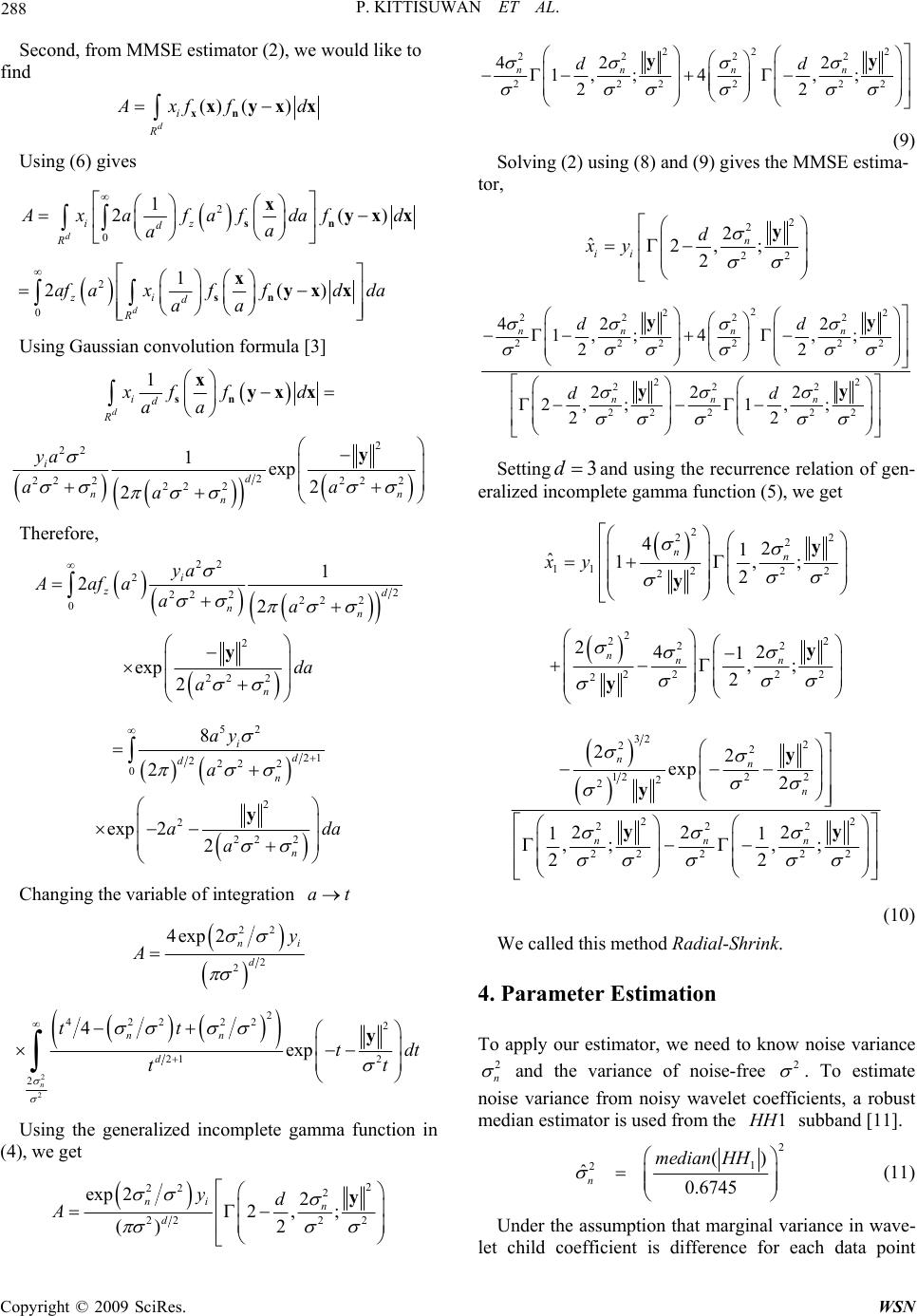 288 P. KITTISUWAN ET AL. Second, from MMSE estimator (2), we would like to find () () di R A xf fd xn xyxx Using (6) gives A 2 0 1 2( diz d R ) x afafdaf d a a sn xyxx 2 0 1 2( d zi d R af axffdda a a sn xyx x) Using Gaussian convolution formula [3] 1 did R xf fd a a sn xyxx 2 22 2 22 222 2 22 2 1exp 2 2 id n n ya a a y n a Therefore, 22 2 2 22 222 2 0 1 2 2 i zd nn ya Aafa aa 2 22 2 exp 2n da a y 52 21 222 2 0 8 2 id d n ay a 2 2 22 2 exp 2 2n ad a ya Changing the variable of integration at 22 2 2 4exp 2ni d y A 2 2 2 42222 2 21 2 2 4 exp n nn d tt td tt y t Using the generalized incomplete gamma function in (4), we get 2 22 2 222 2 exp 22 2, ; 2 () ni n d yd A y 2 22 22 2 2 2222 2 42 2 1, ;4, ; 22 nn n n dd 2 yy (9) Solving (2) using (8) and (9) gives the MMSE estima- tor, 2 2 22 2 ˆ2, ; 2 n ii d xy y 2 22 2222 2222 2 22 22 2 22 222 42 2 1, ;4, ; 22 22 2 2, ;1, ; 22 nn n n nn n dd dd 2 yy yy Setting3d and using thce relation of gen- er comp e recurren alized inlete gamma function (5), we get 22 22 11 22 2 42 1 ˆ1, 2 nn xy y y 2 ; 22 222 22 22 2 242 1,; 2 nnn y y 32 2 22 122 2 2 2 22 222 22 222 22 exp 2 222 11 ,; ,; 22 nn n nnn y y yy (10) We called this method Radial-Shrink. . Parameter Estimation o apply our estimator, we need to know noise variance 4 T 2 n and the variance of noise-free 2 . To estimate e variance from noisy wavelet coefients, a robust median estimator is used from the 1 nois fic H H subband [11]. 2 1 2() ˆ0.6745 n median HH (11) Under the assumption that marginal variance in wave- let child coefficient is difference for each data point Copyright © 2009 SciRes. WSN 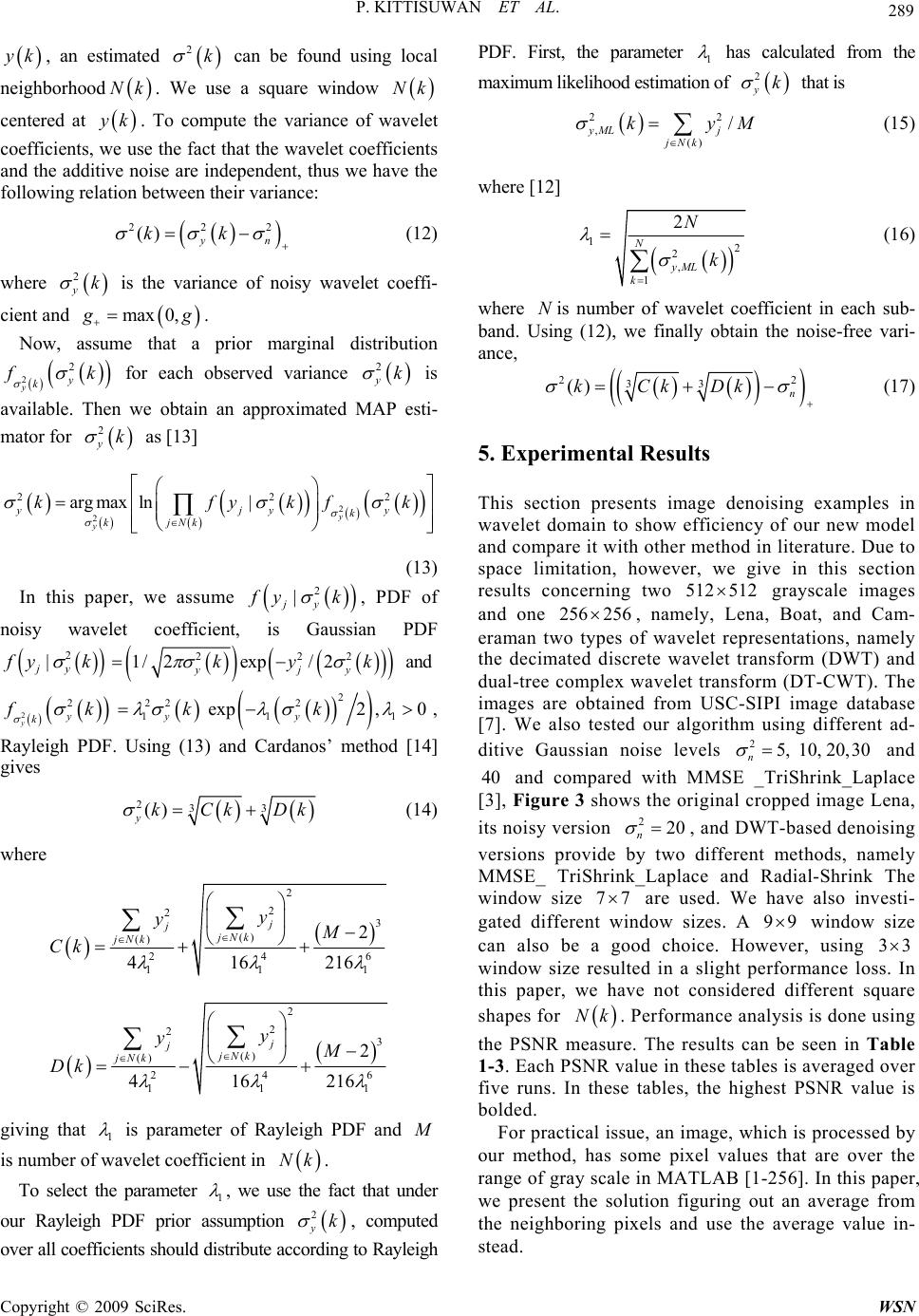 P. KITTISUWAN ET AL. 289 y k, an estimated 2k can be found using local ne borhood Nk. Wee a square window igh us Nk centered at y k. To compute the variance of w coefficients, we use the fact that the wavelet coefficients and the additive noise are independent, thus we have the following relation between their variance: 222 () yn kk avelet (12) where is the variance of no 2 yk d isy wavelet coeffi- cient an max 0, g g. Now, assume that a prior marginal distribution 2 2 yy k f k for each observed variance 2 AP e yk is we obtain an approximated Msti- y available. Then mator for 2k as [13] 2 y k (13) In this paper, we assum 2 2 22 arg maxln|y y yjy k jNk k kfykf e 2 | jy f yk , PDF of noisy wavelet coefficient, is Gaussian PDF 2 | jy f yk 22 1/ 2e yj k k and 2 xp/2y y 2 yy k 2 f k 22 k 1y 2 2 exp2 ,0k , [14] 11y Rayleigh PDF. Using (13) and Cardanos’ method gives 233 () ykCkDk (14) where 2 2 23 () () 24 11 2 416 216 j jjNk jNk y yM Ck 6 1 2 2 23 () () 24 11 2 416216 j jjNk jNk y yM Dk 6 1 giving that 1 is parameter of Rayleigh PDF and M is number of wavelet coefficient in he Nk. To select t parameter 1 , we use the fact that un our Rayleigh PDF prior assumptiok der n computed over all coefficients should distribute according to Rayleigh PD 2 y , F. First, the parameter 1 has calculated from the maximum likelihood estimation of 2 yk t is tha 22 , ( / yML j jNk kyM ) (15) where [12] 12 co 2 , 1 2 N yM k (16) where is number of wat band. Using (12), we finall obtain ance, L N k vele y Nefficient in each sub- the noise-free vari- 22 33 () n kCkDk (17) 5. Experimental Results his section presents imagxamples in ieur new model ace limitation, however, wethis section Te denoising e ncy of o give in wavelet domain to show effic and compare it with other method in literature. Due to sp results concerning two 512 512 grayscale images and one 256256 , namely, Lena, Boat, and Cam- eraman two types of wavelet representations, namely the decimated discrete wavelet transform (DWT) and dual-tree complex wavelet transform (DT-CWT). The images are obtained from USC-SIPI image database [7]. We also tested our algorithm using different ad- ditive Gaussian noise levels 25,10,20, 30 n and 40 and compared with MMSE _TriShrink_Laplace [3], Figure 3 shows the original cropped image Lena, its noisy version 220 n , and Dising sions provide by two different methods, namely MMSE_ TriShrink_Laplace and Radial-Shrink The window size 77 WT-based deno ver are used. We have also investi- gated different window sizes. A 99 window size can also be a good choice. However, using 33 window size resulted in a slight performance loss. In this paper, we have not considered different square shapes for Nk. Performance analysis is done using the PSNR measure. The results can be seen in Table 1-3. Each PSNR value in these tables is averaged over five runs. In te e tables, the highest PSNR value is bolded. For practical issue, an image, which is processed by our method, has some pixel values that are over the range of gray scale in MATLAB [1-256]. In this paper, we prese h s nt the solution figuring out an average from the neighboring pixels and use the average value in- stead. Copyright © 2009 SciRes. WSN 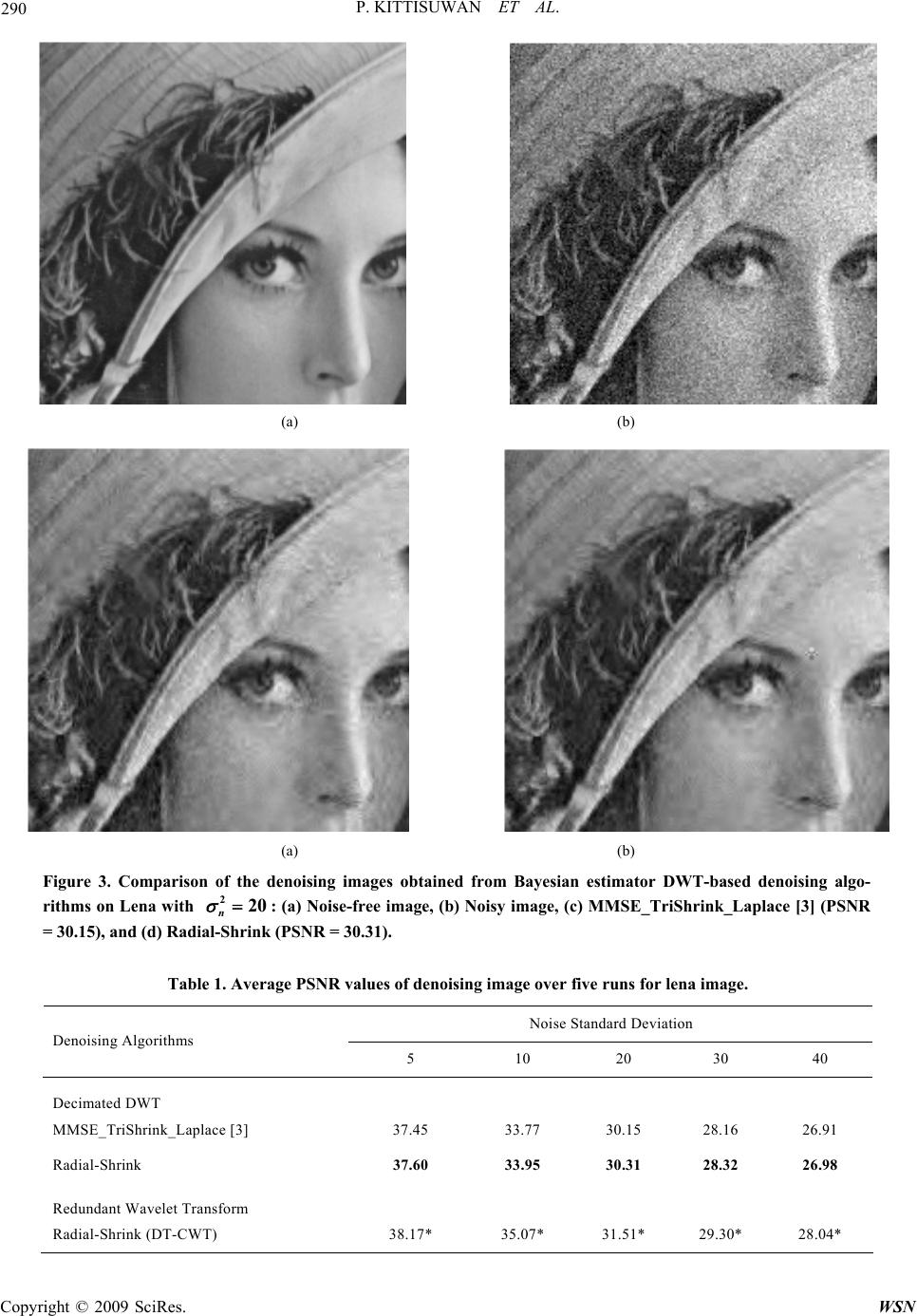 P. KITTISUWAN ET AL. Copyright © 2009 SciRes. WSN 290 (a) (b) (a) (b) Figure 3. Comparison of the denoising images obtained from Bayesian estimator DWT-based denoising algo- rithms on Lena with TriShrink_Laplace [3] (PSNR image over five runs for lena image. 220 n: (a) Noise-free image, (b) Noisy image, (c) MMSE_ = 30.15), and (d) Radial-Shrink (PSNR = 30.31). Table 1. Average PSNR values of denoising Noise Standard Deviation Denoising Algori 5 1030 40 thms 20 Decimated DWT MMSE_TriShrink_Laplace [3] 37.45 33.77 30.15 28.16 26.91 elet Transform Radial-Shrink (DT-CWT) 38.17* 35.07* 31.51* 29.30* 28.04* Radial-Shrink 37.60 33.95 30.31 28.32 26.98 Redundant Wav 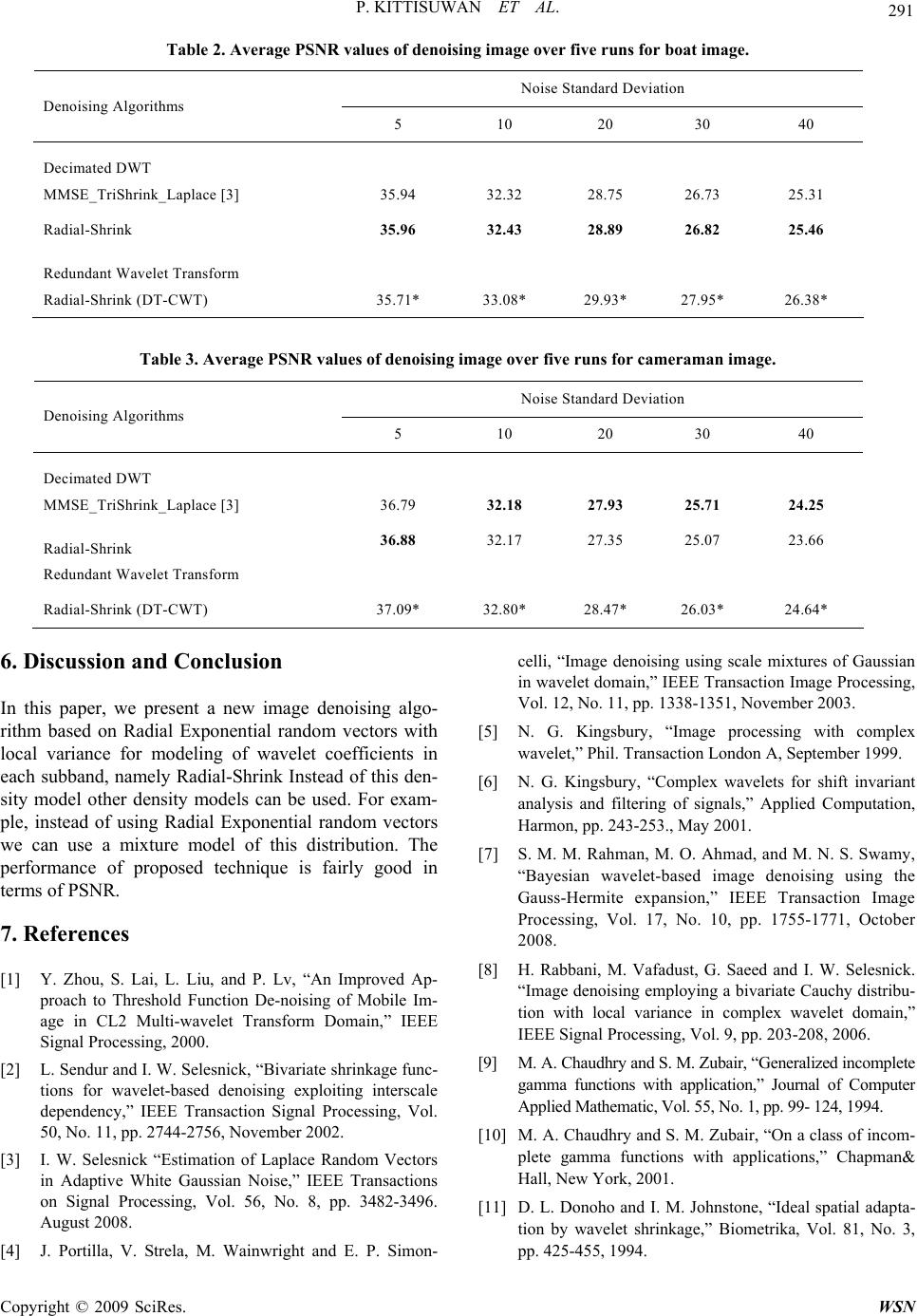 P. KITTISUWAN ET AL. 291 Table 2. Average PSNR values of denoising image over five runs for boat image. tandation Noise Sard Devi Denoisin 40 g Algorithms 5 10 20 30 Decimated DWT MMSE_TriShrink_Laplace [3] 35 3 2 2 2 35.96 32.43 28.89 26.82 25.46 DT-CWT) .942.328.75 6.735.31 Radial-Shrink Redundant Wavelet Transform Radial-Shrink (35.71* 33.08* 29.93* 27.95* 26.38* e PSNR values of denoising image over five rueram Noise Standard Deviation Table 3. Averagns for caman image. Denoising Algo 40 rithms 5 10 20 30 Decimated DWT MMSE_TriShrink_Laplace [3] 36 3 2 2 2 36.88 32.17 27.35 25.07 23.66 DT-CWT) .79 2.187.93 5.714.25 Radial-Shrink Redundant Wavelet Transform Radial-Shrink (37.09* 32.80* 28.47* 26.03* 24.64* 6. Discussion and Conc this paper, we present a new image denoising algo- ndom vectors with cal variance for modeling of wavelet coefficients in Lai, L. Liu, and P. Lv, “An Improved Ap- shold Function De-noising of Mobile Im- ulti-wavelet Transform Domain,” IEEE action Signal Processing, Vol. 3482-3496. celli, “Image denoising using scale mixtures of Gaussian waveln,” IEsactionProcessing, Vol. 12, No. 11, pp. 1338-1351, November 2003. Transaction London A, September 1999. wamy, d and I. W. Selesnick. ons with application,” Journal of Computer lusion In rithm based on Radial Exponential ra lo Aug each subband, namely Radial-Shrink Instead of this den- sity model other density models can be used. For exam- ple, instead of using Radial Exponential random vectors we can use a mixture model of this distribution. The performance of proposed technique is fairly good in terms of PSNR. 7. References ] Y. Zhou, S. [1 proach to Thre age in CL2 M “Im Signal Processing, 2000. [2] L. Sendur and I. W. Selesnick, “Bivariate shrinkage func- tions for wavelet-based denoising exploiting interscale dependency,” IEEE Trans 50, No. 11, pp. 2744-2756, November 2002. [3] I. W. Selesnick “Estimation of Laplace Random Vectors in Adaptive White Gaussian Noise,” IEEE Transactions on Signal Processing, Vol. 56, No. 8, pp. ust 2008. [4] J. Portilla, V. Strela, M. Wainwright and E. P. Simon- [5] N. G. Kingsbury, “Image processing with complex wavelet,” Phil. in et domaiEE Tran Image [6] N. G. Kingsbury, “Complex wavelets for shift invariant analysis and filtering of signals,” Applied Computation, Harmon, pp. 243-253., May 2001. [7] S. M. M. Rahman, M. O. Ahmad, and M. N. S. S “Bayesian wavelet-based image denoising using the Gauss-Hermite expansion,” IEEE Transaction Image Processing, Vol. 17, No. 10, pp. 1755-1771, October 2008. [8] H. Rabbani, M. Vafadust, G. Saee age denoising employing a bivariate Cauchy distribu- tion with local variance in complex wavelet domain,” IEEE Signal Processing, Vol. 9, pp. 203-208, 2006. [9] M. A. Chaudhry and S. M. Zubair, “Generalized incomplete gamma functi Applied Mathematic, Vol. 55, No. 1, pp. 99- 124, 1994. [10] M. A. Chaudhry and S. M. Zubair, “On a class of incom- plete gamma functions with applications,” Chapman& Hall, New York, 2001. [11] D. L. Donoho and I. M. Johnstone, “Ideal spatial adapta- tion by wavelet shrinkage,” Biometrika, Vol. 81, No. 3, pp. 425-455, 1994. Copyright © 2009 SciRes. WSN 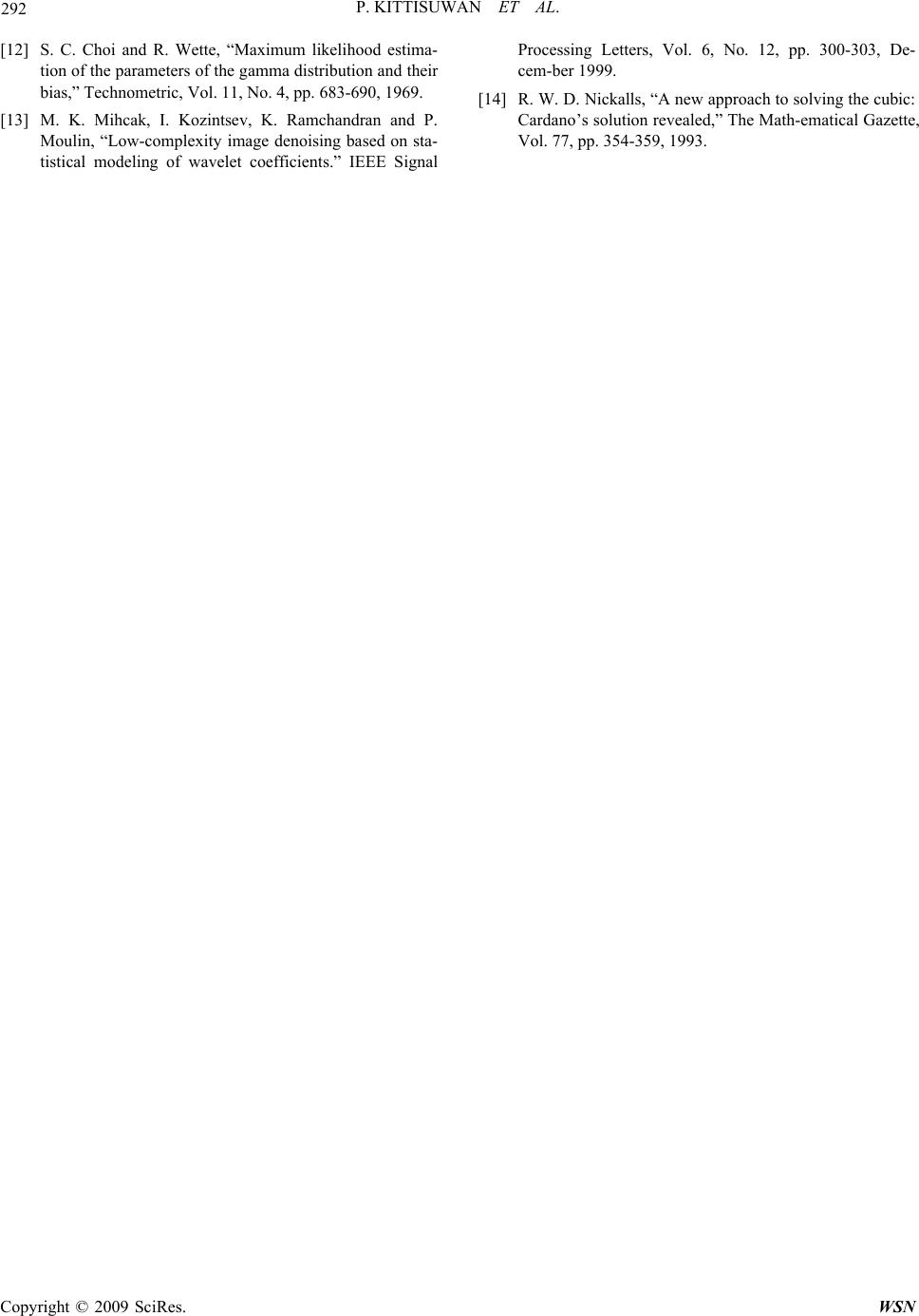 P. KITTISUWAN ET AL. 292 l. 11, No. 4, pp. 683-690, 1969. wavelet coefficients.” IEEE Signal -359, 1993. [12] S. C. Choi and R. Wette, “Maximum likelihood estima- tion of the parameters of the gamma distribution and their bias,” Technometric, Vo [13] M. K. Mihcak, I. Kozintsev, K. Ramchandran and P. Moulin, “Low-complexity image denoising based on sta- tistical modeling of Processing Letters, Vol. 6, No. 12, pp. 300-303, De- cem-ber 1999. [14] R. W. D. Nickalls, “A new approach to solving the cubic: Cardano’s solution revealed,” The Math-ematical Gazette, Vol. 77, pp. 354 Copyright © 2009 SciRes. WSN |

